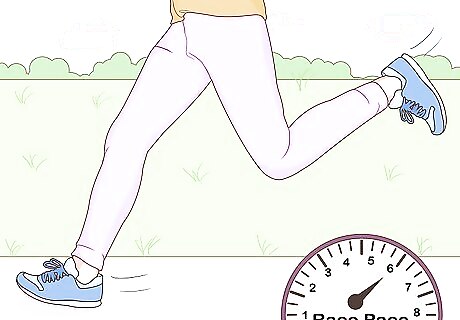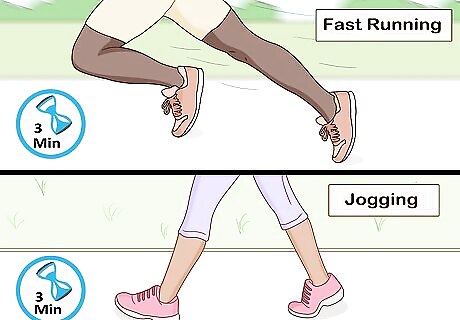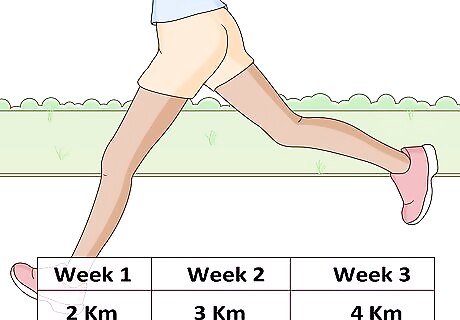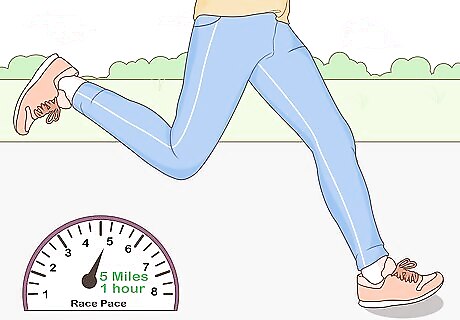
views
Improving Running Endurance

Try interval training. Interval training involves alternating between periods (known as intervals) of high-intensity exercise with low-intensity exercise. Switch between sprinting and walking in 2 to 3 minute intervals. This is very good for stamina.Your run can last anywhere from thirty minutes to an hour, depending on the distance you choose. During the high-intensity interval, give the workout as much energy as you can to increase your strength. Plan an interval run at least once per week. EXPERT TIP Tyler Courville Tyler Courville Professional Runner Tyler Courville is a brand ambassador for Salomon Running. He has run in 10 ultra and mountain races across the United States and Nepal, and won the 2018 Crystal Mountain Marathon. Tyler Courville Tyler Courville Professional Runner Tyler Courville, ultra and mountain runner, advises: “I think for most people when you’re beginning it’s helpful to do a weekly rotation, which consists of one long run a week, one kind of interval, and maybe one up-tempo run. Then, the rest of the days, I let my body guide what I'm doing. My mentality is that if your run doesn’t have a name (if it’s not long run or hill sprints, for example) then it’s recovery.”

Do twenty-minute tempo runs. Run at a speed 15 to 30 seconds slower than your race pace to practice controlling your speed. On a scale from one to ten, tempo runs should put your exertion level at around an eight. Because tempo runs increase metabolic fitness, this exercise can prevent fatigue on your race day.

Run a fartlek workout. Fartlek is Swedish for "speed play," and this workout is a variation of interval training meant to prepare you for the varied pacing of cross country runs. Instead of alternating between an intense and easy workout, your pace will vary between intense and moderate. A good fartlek workout can last anywhere from thirty minutes to an hour. For example, you might sprint for three minutes, jog for three minutes, and then repeat this process five times. Practice fartlek runs on uneven courses with plenty of uphill and downhill to simulate racing conditions.

Work in a 10% longer run every week. It is important to build up your running distance gradually. To do this, plan a 10% longer run every week to work up to the race's distance. For example, if you're running a 5K (3.1 mi), you could run 2 kilometers (1.2 mi) one week, 2.2 kilometers (1.4 mi) the next, and 2.4 kilometers (1.5 mi) the next week. Keep increasing your distance by 10% until you reach your goal of 5k (3.1) miles. Don't start out at your fastest pace during longer runs. Start slow and gradually build your speed. Do not plan your long run on the day before your competition to avoid burnout.

Plan one recovery run a week. On the day after your longer run, do a recovery run to decrease lactic acid buildup in your muscles (which can cause stiffness). Maintain a steady, slow pace for around 20 to 30 minutes. You should be able to breathe and talk with ease while you run. Recovery runs also reduce the effect of delayed onset muscle soreness (DOMS) after heavy workouts.
Cross-Training

Work in two or three cross-training days per week. While training for a cross country competition, three or four days should consist of running. For the remaining days, try other exercises to strengthen your full body and give your running muscles a break. Choose cross-training workouts you enjoy. You might, for example, swim, bike, ski, weight lift, or hike.

Have one rest day per week as part of your cross-training schedule. Rest days allow your muscles to recover and avoid driving your body to exhaustion. Without a rest day, athletes are much more likely to sustain injuries. Plan a day to recharge, perform a light activity, and prepare for your workout tomorrow. Examples of rest day activities include: stretching, walking, visiting a hot tub or sauna, hiking on an even trail, or doing yoga.

Go cycling to increase your running speed. Pedaling on a bike can help you even out the cadence of your running, or how many steps you take per minute. Begin your cycling workout on a low tension setting to ease into the workout. Gradually increase the tension as you cycle to simulate going up hills. Work in 60-90 second intervals of high-tension cycling followed by low-tension recovery periods to interval train on the bike. If desired, you can go biking outdoors as an alternative. Look for a road or a trail with equal amounts of uphill and downhill.

Try weight training once a week for endurance. Because endurance is key in cross country runs, schedule a strength training session weekly. Alternate between focusing on your arms, legs, and core during different weightlifting sessions. Start with lights weights and move onto heavier ones as you gain muscle.

Go swimming for an upper-body workout. Running mainly focuses on lower-body training, so swimming can keep your body balanced as you train. Lap swimming in a pool (as opposed to open water swimming) is ideal for cross-training, especially if you are new to swimming. Swimming workouts can last anywhere from thirty minutes to an hour, depending on how many laps you want to complete.
Maintaining a Healthy Lifestyle

Get at least eight hours of sleep every night. Keeping healthy sleep habits will help you give your all during each workout or race. Most teenagers and adults need between 8-9 hours of sleep per week. If you are a younger athlete (in middle or high school), try to get between eight and ten hours of sleep.

Eat plenty of protein and carbohydrates. Carbohydrates provide the body with energy and stamina during hard workouts. Protein stabilizes blood sugar and helps you stay full. Aim for a serving of each in every meal to give your body balanced nutrition. Runners should aim to get sixty to sixty-five percent of their calories from carbohydrates. Pasta, bread, cereal, dairy, sports drinks, and fruits are all great sources of carbs. Healthy food with a high protein content include: eggs, nuts, beans, tofu, and white meat.

Avoid foods with a high fat content. Some fat is important, but a runner's diet should be relatively low in fat. It should make up around twenty percent of your caloric intake and primarily come from monounsaturated fats (like avocados, olive oil, and nuts) instead of saturated fats (like whole milk, red meat, and butter).

Stay hydrated. Drinking enough water can increase a runner's speed and stamina. How much water you should drink during a workout depends on the intensity and the environment you're exercising in. Keep an accessible supply of water or a sports drink with you while you exercise, and drink when you feel thirsty or notice signs of dehydration. Try to drink at least 2–3 liters (0.53–0.79 US gal) (9-13 cups) of water per day. Dehydration symptoms include: dizziness, dry mouth, excessive sweating, fatigue, extreme thirst, dark or strong smelling urine, or confusion.

Stretch after running. It is important to stretch your muscles after you complete a run. Stretching will help to alleviate cramps and release tension in your muscles. Stretch your legs, especially your calves, to help prevent cramping.
Doing Your Best at Competitions

Inspect the race trail several days before you run. Ask your coach for a map of the course or, if running independently, check the race website for a map. Study the course either in-person or via the map, and make note of challenging areas (like long, steep hills). Make a racing plan as you survey the area so you can decide on a strategy. Suppose you notice three big hills near the end of your race. You could plan to run at a slower pace before you reach these hills to conserve energy.

Eat high-carbohydrate foods four hours before your race. Four hours gives your body enough time to digest the food and turn it into energy. At least eighty percent of your pre-race meal should be carbohydrates. Avoid food with high fat, fiber, or protein content. Drink something with a high carbohydrate content, like chocolate milk or a sports drink. Bread, oatmeal, or pasta all make ideal meals before a race.

Practice visualization before the race begins. Imagining yourself doing your best and reaching your goals can actually help you achieve them. One or two hours beforehand, picture yourself running the race and doing well. When it's time to race, you'll feel more confident and prepared to compete. Include vivid details, like the weather or the runners around you, to make the visualization seem real. Picture positive as well as negative moments. When setbacks occur during the race, you'll face them with less anxiety.

Run at an even pace. Fully exerting yourself at the beginning of a cross country race will swiftly sap your stamina. If your sprinting pace is eight miles per hour, go for five or six miles per hour at first. Increase your speed as you near the end of the race.
Make the most of your strengths. Run fastest in the areas you feel most confident in. If you love running downhill, speed your way down. Or, if you prefer uphill running, conserve your energy on the even or downhill areas so you can climb the hills with confidence.




















Comments
0 comment